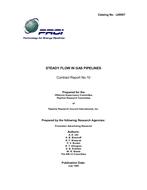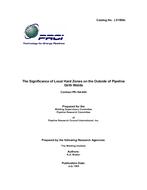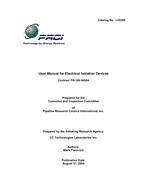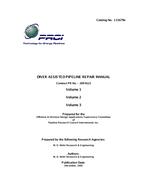Provide PDF Format
PRCI NB 13
- Steady Flow in Gas Pipelines (IGT#10)
- Report / Survey by Pipeline Research Council International, 07/01/1970
- Publisher: PRCI
$75.00$149.00
L00007e
Institute of Gas technology
Need: This report presents the results of extended investigations into aspects of steady flow in gas pipelines. The essential problem under study was the accurate specification of flow behavior in operating pipelines. Coupled with the information of previously existing analytic theory and the results of extensive laboratory experiments, this effort could then be considered to furnish the third essential element of substantiation of a fully general picture of pipeline flow behavior.
Benefit: To accurately evaluate the nature of the transmission factor, an extensive experimental program was initiated in which tests were run and data gathered on the friction encountered by gas flowing in seamless pipe sections and in tubes with specially prepared interiors. There are three main areas of investigation. First, procedures for line performance testing are established which will permit an analysis of line performance or flow behavior to the same degree of accuracy as the flow metering technique employed. Recommendations are made concerning the use of test equipment. Techniques are given for the evaluation of the accuracy of all test data and calculated results. Second, the use of tracers for flow measurement is discussed. Two more accurate tracer metering techniques are presented. Third, a review of flow behavior theory, a summary of laboratory experiments on flow behavior, and the results of the analysis on over 40 pipeline tests is discussed. This material is used to develop a pair of pipeline flow equations valid for operating conditions in contemporary American transmission systems.
Result: In the course of this study, existing methods of flow metering with tracers were reviewed and their accuracy determined. As a result, two new, highly accurate tracer metering techniques were developed. One result of this study has been the development of a pair of pipeline flow equations which, in combination, are valid for all steady-flow conditions found in contemporary American transmission lines. One equation pertains to partially turbulent flow, the other to fully turbulent flow. The first is based on the smooth-pipe law, modified to account for such drag-inducing elements as weld beads, bends, and valve settings in the line. The second, based on the rough-pipe law, involves the interior effective or operating roughness of the line, a composite effect of the wall roughness and the drag-inducing elements.
Institute of Gas technology
Need: This report presents the results of extended investigations into aspects of steady flow in gas pipelines. The essential problem under study was the accurate specification of flow behavior in operating pipelines. Coupled with the information of previously existing analytic theory and the results of extensive laboratory experiments, this effort could then be considered to furnish the third essential element of substantiation of a fully general picture of pipeline flow behavior.
Benefit: To accurately evaluate the nature of the transmission factor, an extensive experimental program was initiated in which tests were run and data gathered on the friction encountered by gas flowing in seamless pipe sections and in tubes with specially prepared interiors. There are three main areas of investigation. First, procedures for line performance testing are established which will permit an analysis of line performance or flow behavior to the same degree of accuracy as the flow metering technique employed. Recommendations are made concerning the use of test equipment. Techniques are given for the evaluation of the accuracy of all test data and calculated results. Second, the use of tracers for flow measurement is discussed. Two more accurate tracer metering techniques are presented. Third, a review of flow behavior theory, a summary of laboratory experiments on flow behavior, and the results of the analysis on over 40 pipeline tests is discussed. This material is used to develop a pair of pipeline flow equations valid for operating conditions in contemporary American transmission systems.
Result: In the course of this study, existing methods of flow metering with tracers were reviewed and their accuracy determined. As a result, two new, highly accurate tracer metering techniques were developed. One result of this study has been the development of a pair of pipeline flow equations which, in combination, are valid for all steady-flow conditions found in contemporary American transmission lines. One equation pertains to partially turbulent flow, the other to fully turbulent flow. The first is based on the smooth-pipe law, modified to account for such drag-inducing elements as weld beads, bends, and valve settings in the line. The second, based on the rough-pipe law, involves the interior effective or operating roughness of the line, a composite effect of the wall roughness and the drag-inducing elements.





